Andrea Palladio
| Andrea Palladio | |
|---|---|
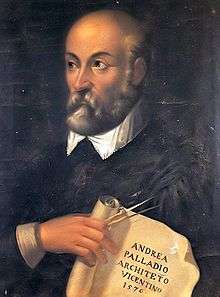 Portrait of Palladio from the 17th century | |
| Born |
30 November 1508 Padova, |
| Died |
19 August 1580 (aged 71) Maser, near Treviso |
| Nationality | Italian[1] |
| Occupation | Architect |
| Buildings |
Villa Barbaro Villa Capra "La Rotonda" Basilica Palladiana Church of San Giorgio Maggiore Il Redentore Teatro Olimpico |
| Projects | I Quattro Libri dell'Architettura (The Four Books of Architecture) |
Andrea Palladio (Italian pronunciation: [anˈdrɛːa palˈlaːdjo]; 30 November 1508 – 19 August 1580) was an Italian[1] architect active in the Venetian Republic. Palladio, influenced by Roman and Greek architecture, primarily by Vitruvius, is widely considered to be one of the most influential individuals in the history of architecture. All of his buildings are located in what was the Venetian Republic, but his teachings, summarized in the architectural treatise, The Four Books of Architecture, gained him wide recognition.[2] The city of Vicenza, with its twenty-three buildings designed by Palladio, and the Palladian Villas of the Veneto are listed together as UNESCO World Heritage Sites.
Biography
Palladio was born on 30 November 1508 in Padua and was given the name, Andrea Di Pietro della Gondola.[3] His father, Pietro, called "Della Gondola", was a miller. From early on, Andrea Palladio was introduced into the work of building. In Padua he gained his first experiences as a stonecutter in the sculpture workshop of Bartolomeo Cavazza da Sossano, who was the sculptor responsible for the altar in the Church of Santa Maria dei Carmini in Padua.[4] Cavazza da Sossano is said to have imposed particularly hard working conditions. At the age of sixteen he moved to Vicenza where he would reside for most of his life. Here he became an assistant in the Pedemuro studio, a leading workshop of stonecutters and masons. He joined a guild of stonemasons and bricklayers. He was employed as a stonemason to make monuments and decorative sculptures. These sculptures reflected the Mannerist style of the architect Michele Sanmicheli.
Perhaps the key moment that sparked Palladio's career was being employed by the Humanist poet and scholar, Gian Giorgio Trissino, from 1538 to 1539. While Trissino was reconstructing the Villa Cricoli, he took interest in Palladio's work. Trissino was heavily influenced by the studies of Vitruvius, who later influenced Palladio's own ideals and attitudes toward classical architecture. As the leading intellectual in Vicenza, Trissino stimulated the young man to appreciate the arts, sciences, and Classical literature and he granted him the opportunity to study Ancient architecture in Rome.[5] It was also Trissino who gave him the name by which he became known, Palladio, an allusion to the Greek goddess of wisdom Pallas Athene and to a character of a play by Trissino. Indeed, the word Palladio means Wise one.[6] After Trissino's death in 1550, Palladio benefited from the patronage of the Barbaro brothers, Cardinal Daniele Barbaro, who encouraged his studies of classical architecture and brought him to Rome in 1554, and his younger brother Marcantonio Barbaro. The powerful Barbaros introduced Palladio to Venice, where he finally became "Proto della Serenissima" (chief architect of the Republic of Venice) after Jacopo Sansovino.[7] In addition to the Barbaros, the Corner, Foscari, and Pisani families supported Palladio's career.[8]
Andrea Palladio began to develop his own architectural style around 1541. The Palladian style, named after him, adhered to classical Roman principles he rediscovered, applied, and explained in his works.[9]
Andrea Palladio is known to be one of the most influential architects in Western architecture. His architectural works have "been valued for centuries as the quintessence of High Renaissance calm and harmony" (Watkin, D., A History of Western Architecture). He designed many palaces, villas, and churches, but Palladio's reputation, initially, and after his death, has been founded on his skill as a designer of villas.[10] The palladian villas are located mainly in the province of Vicenza, while the palazzi are concentrated in the city of Vicenza and the churches in Venice. A number of his works are now protected as part of the World Heritage Site City of Vicenza and the Palladian Villas of the Veneto. Other buildings by Palladio are to be found within the Venice and its Lagoon World Heritage Site.
Palladio's first major public project began when his designs for building the loggias for the town hall, known as the Basilica Palladiana, were approved in 1548. He proposed an addition of two-storey stone buttresses reflecting the Gothic style of the existing hall while using classical proportions. The construction was completed in 1617 after Palladio's death.
Aside from Palladio's designs, his publications contributed to Palladianism. During the second half of his life, Palladio published many books, above all, I Quattro Libri dell'Architettura (The four books of architecture, Venice, 1570). Palladio is most known for his designs of villas and palaces as well as his books.
The precise circumstances of his death are unknown. Palladio died in 1580,[11] retold in tradition, in Maser, near Treviso, and was buried in the church of Santa Corona in Vicenza; since the nineteenth century his tomb has been located in the Cimitero Maggiore of Vicenza.
Cultural context
.jpg)
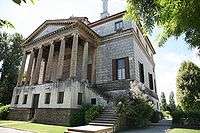
Palladio's architecture was not dependent on expensive materials, which must have been an advantage to his more financially pressed clients. Many of his buildings are of brick covered with stucco. Stuccoed brickwork was always used in his villa designs in order to portray his interpretations of the Roman villa typology.
In the later part of his career, Palladio was chosen by powerful members of Venetian society for numerous important commissions. His success as an architect is based not only on the beauty of his work, but also for its harmony with the culture of his time. His success and influence came from the integration of extraordinary aesthetic quality with expressive characteristics that resonated with his client's social aspirations. His buildings served to communicate, visually, their place in the social order of their culture. This powerful integration of beauty and the physical representation of social meanings is apparent in three major building types: the urban palazzo, the agricultural villa, and the church.
Relative to his trips to Rome, Palladio developed three main palace types by 1556. In 1550, the Palazzo Chiericati was completed. The proportions for the building were based on musical ratios for adjacent rooms. The building was centralized by a tripartite division of a series of columns or colonnades. In 1552, the Palazzo Iseppo Porto located in Vicenza was rebuilt incorporating the Roman Renaissance element for façades. A colonnade of Corinthian columns surrounded a main court. The Palazzo Antonini in Udine, constructed in 1556, had a centralized hall with four columns and service spaces placed relatively toward one side. He uses styles of incorporating the six columns, supported by pediments, into the walls as part of the façade. This technique had been applied in his villa designs as well. Palladio experimented with the plan of the Palazzo Iseppo Porto by incorporating it into the Palazzo Thiene. It was an earlier project from 1545 to 1550 and remained uncompleted due to elaborate elevations in his designs. He used Mannerist elements such as stucco surface reliefs and large columns, often extending two stories high.
In his urban structures he developed a new improved version of the typical early Renaissance palazzo (exemplified by the Palazzo Strozzi). Adapting a new urban palazzo type created by Bramante in the House of Raphael, Palladio found a powerful expression of the importance of the owner and his social position. The main living quarters of the owner on the second level were clearly distinguished in importance by use of a pedimented classical portico, centered and raised above the subsidiary and utilitarian ground level (illustrated in the Palazzo Porto and the Palazzo Valmarana). The tallness of the portico was achieved by incorporating the owner's sleeping quarters on the third level, within a giant two-story classical colonnade, a motif adapted from Michelangelo's Capitoline buildings in Rome. The elevated main floor level became known as the "piano nobile", and is still referred to as the "first floor" in Europe.
.jpg)
Palladio also established an influential new building format for the agricultural villas of the Venetian aristocracy. Palladio's approach to his villa designs was not relative to his experience in Rome. His designs were based on practicality and employed few reliefs. He consolidated the various stand-alone farm outbuildings into a single impressive structure, arranged as a highly organized whole, dominated by a strong center and symmetrical side wings, as illustrated at Villa Barbaro. In the project of the Villa Barbaro, Palladio most likely was also engaged in the interior decoration. Alongside the painter Paolo Veronese, he invented the complex and sophisticated illusionistic landscape paintings that cover the walls of various rooms.[12] The Villa Rotonda of 1552, outside Vicenza, was constructed as a summer house with views from all four sides. The plan has centralized circular halls with wings and porticos expanding on all four sides. Palladio began to implement the classical temple front into his design of façades for villas. He felt that to make an entry appear grand, the Roman temple front would be the most suitable style. The Palladian villa configuration often consists of a centralized block raised on an elevated podium, accessed by grand steps, and flanked by lower service wings, as at Villa Foscari and Villa Badoer. This format, with the quarters of the owners at the elevated center of their own world, found resonance as a prototype for Italian villas and later for the country estates of the British nobility (such as Lord Burlington's Chiswick House, Vanbrugh's Blenheim, Walpole's Houghton Hall, and Adam's Kedleston Hall and Paxton House in Scotland). His villas were used by a capitalist gentry who developed an interest in agriculture and land. The configuration was a perfect architectural expression of their worldview, clearly expressing their perceived position in the social order of the times. His influence was extended worldwide into the British colonies. Palladio developed his own prototype for the plan of the villas that was flexible to moderate in scale and function. The Palladian villa format was easily adapted for a democratic worldview, as may be seen at Thomas Jefferson's Monticello and his arrangement for the University of Virginia. It also may be seen applied as recently as 1940 in Pope's National Gallery in Washington D.C., where the public entry to the world of high culture occupies the exalted center position. The rustication of exposed basement walls of Victorian residences is a late remnant of the Palladian format, clearly expressed as a podium for the main living space for the family.
Similarly, Palladio created a new configuration for the design of Catholic churches that established two interlocking architectural orders, each clearly articulated, yet delineating a hierarchy of a larger order overriding a lesser order. This idea was in direct coincidence with the rising acceptance of the theological ideas of St. Thomas Aquinas, who postulated the notion of two worlds existing simultaneously: the divine world of faith, and the earthly world of humans. Palladio created an architecture which made a visual statement communicating the idea of two superimposed systems, as illustrated at San Francesco della Vigna. In a time when religious dominance in Western culture was threatened by the rising power of science and secular humanists, this architecture found great favor with the Catholic Church as a clear statement of the proper relationship of the earthly and the spiritual worlds.
Influence
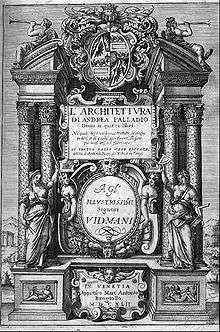
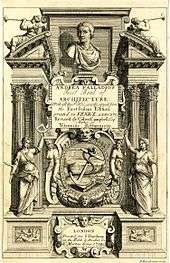
Although his buildings are all in a relatively small part of Italy, Palladio's influence was far-reaching. One factor in the spread of his influence was the publication in 1570 of his architectural treatise, I Quattro Libri dell'Architettura (The Four Books of Architecture), which set out rules others could follow. The first book includes studies of decorative styles, classical orders, and materials. The second book included Palladio's town and country house designs and classical reconstructions. The third book has bridge and basilica designs, city planning designs, and classical halls. The fourth book included information on the reconstruction of ancient Roman temples. Before this landmark publication, architectural drawings by Palladio had appeared in print as illustrations to Daniele Barbaro's "Commentary" on Vitruvius.[13]
Interest in his style was renewed in later generations and became fashionable throughout Europe, for example in parts of the Loire Valley of France. In Britain, Inigo Jones, Elizabeth Wilbraham, and Christopher Wren embraced the Palladian style. In his Italian Journey, Johann von Goethe describes Palladio as a genius, commending his unfinished Convent of Saint Maria della Carita as the most perfect existing work of architecture. Another admirer was the architect, Richard Boyle, 4th Earl of Cork, also known as Lord Burlington, who, with William Kent, designed Chiswick House. The influence of Palladio even spread to America. Thomas Jefferson and Thomas Dawes much admired that style of architecture, and the United States Capitol building is an example of a slightly evolved version of Palladio's works. The One Hundred Eleventh Congress of the United States of America called him the "Father of American Architecture"[14] (Congressional Resolution no. 259 of 6 December 2010). Exponents of Palladianism include the eighteenth century Venetian architect, Giacomo Leoni, who published an authoritative four-volume work on Palladio and his architectural concepts.
More than 330 of Palladio's original drawings and sketches still survive in the collections of the Royal Institute of British Architects,[15] most of which originally were owned by Inigo Jones. Jones collected a significant number of these on his Grand Tour of 1613–1614, while some were a gift from Henry Wotton.[16]
The Center for Palladian Studies in America, Inc., a nonprofit membership organization, was founded in 1979 to research and promote understanding of Palladio's influence in the architecture of the United States.
In 2010, the National Building Museum in Washington, D.C. created an exhibition dedicated solely to Palladio and his legacy. The exhibition, titled Palladio and His Legacy: A Transatlantic Journey,[17] was open to the public until January 2011.
Chronology of the works
Note: the chronology[18] is generally referred to the project of the works, not to the construction.
Villas
- 1534 (built 1534 – 1538): Villa Trissino a Cricoli, Vicenza (once traditionally attributed, but probably designed by Gian Giorgio Trissino)
- 1537 (built 1539 – 1557): Villa Godi, for Girolamo, Pietro and Marcantonio Godi, Lonedo di Lugo di Vicenza
- c. 1539 (built 1539 – 1587): Villa Piovene, Lonedo di Lugo di Vicenza, Province of Vicenza (uncertain attribution)
- Before 1542 (built 1542 – c. 1550): Villa Gazzotti, for Taddeo Gazzotti, Bertesina, Vicenza
- 1542 (built 1542 – 1560): Villa Valmarana, for Giuseppe and Antonio Valmarana, Vigardolo di Monticello Conte Otto, Province of Vicenza
- 1542 (built 1542 – 1545): Villa Pisani, for Vettore, Marco and Daniele Pisani, Bagnolo di Lonigo, Province of Vicenza
- 1542 ? (built before 1545 – 1550): Villa Thiene, for Marcantonio e Adriano Thiene, Quinto Vicentino, Province of Vicenza (probably a re-elaboration of a project by Giulio Romano)
- c. 1546: Villa Contarini degli Scrigni, for Paolo Contarini and brothers, Piazzola sul Brenta, Province of Padua (attributed)
- 1547 (built 1547, 1565): Villa Arnaldi, for Vincenzo Arnaldi, Meledo di Sarego, Province of Vicenza (unfinished)
- c. 1548 (built 1548 – before 1555): Villa Saraceno, for Biagio Saraceno, Finale di Agugliaro, Province of Vicenza
- 1548 (built 1554 – 1556): Villa Angarano, for Giacomo Angarano, Bassano del Grappa, Province of Vicenza (main body of the villa later rebuilt by Baldassarre Longhena; the barchesse are part of the original)
- 1549 (built 1549 – 1563): Villa Pojana, for Bonifacio Pojana, Pojana Maggiore, Province of Vicenza
- After 1550 (built c. 1555 – 1584): Villa Chiericati, for Giovanni Chiericati, Vancimuglio di Grumolo delle Abbadesse, Province of Vicenza (completed in 1584 by Domenico Groppino after Palladio's death)
- 1552 (built 1552; 1569; 1588): Villa Cornaro, for Giorgio Cornaro, Piombino Dese, Province of Padua
- c. 1552 (built 1552 – 1555): Villa Pisani, for Francesco Pisani, Montagnana, Province of Padua
- c. 1553: Villa Ragona Cecchetto, per Girolamo Ragona, Ghizzole di Montegaldella, Province of Padua (unbuilt project)
- c. 1553 (built 1553 – 1554; 1575): Villa Trissino, Meledo di Sarego, Province of Vicenza (only partially realized)
- 1554 (built 1554 – 1558): Villa Porto, for Paolo Porto, Vivaro di Dueville, Province of Vicenza (attributed)
- c. 1554 (built 1554 – 1558): Villa Barbaro, for Daniele and Marcantonio Barbaro, Maser, Province of Treviso
- 1554 ? (built 1560 – 1565): Villa Foscari called "La Malcontenta", for Nicolò and Alvise Foscari, Malcontenta di Mira, Province of Venice
- 1554 ? (built: 1555 ?): Villa Zeno, for Marco Zeno, Donegal di Cessalto, Province of Treviso
- 1554 ? (built 1560–1564): Villa Mocenigo "sopra la Brenta", Dolo, Province of Venice) (demolished)
- 1554 – c. 1555 (built before 1556): Villa Badoer called "La Badoera", for Francesco Badoer, Fratta Polesine, Province of Rovigo
- before 1556 (built 1559 – 1565): Villa Emo, for Leonardo Emo, Fanzolo di Vedelago, Province of Treviso
- 1556 (built 1563 – 1567): Villa Thiene, for Francesco Thiene and sons, Cicogna di Villafranca Padovana, Province of Padua (unfinished; only a barchessa remaining)
- 1560 ? (built after 1563 – before 1565; after 1570 ?): Villa Repeta, for Mario Repeta, Piazza Vecchia, Campiglia dei Berici, Province of Vicenza (destroyed by a fire, then rebuilt in other shape in 1672)
- c. 1561 (built before 1569): Big barchesse of villa Pisani, Bagnolo di Lonigo, Province of Vicenza (attributed; destroyed)
- 1562 (built 1564 – 1566): Villa Sarego called "La Miga", for Annibale Serego, Miega di Cologna Veneta, Province of Verona (unfinished, demolished in the 1920s)
- c 1563 (built 1564 – 1566): Villa Valmarana, for Gianfrancesco Valmarana, Lisiera di Bolzano Vicentino, Province of Vicenza
- After 1564 (built 1565 – 1570): Villa Forni Cerato, for Girolamo Forni, Montecchio Precalcino, Province of Vicenza
- 1565 (built 1565 – c. 1585): Villa Serego, for Marcantonio Serègo, Santa Sofia di Pedemonte di San Pietro in Cariano, Province of Verona
- 1566 – 1567 (built 1567 – 1605): Villa Almerico Capra called "La Rotonda", for Paolo Almerico, Vicenza (completed in 1585 by Vincenzo Scamozzi after Palladio's death)
- 1570 (built 1572 – 1580): Villa Porto, for Iseppo da Porto, Molina di Malo, Province of Vicenza (unfinished)
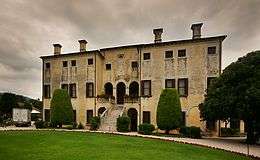 One of the first works by Palladio, Villa Godi
One of the first works by Palladio, Villa Godi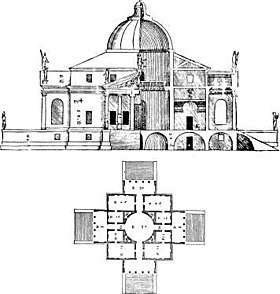 Palladio's plan of Villa La Rotonda, in I Quattro Libri dell'Architettura, 1570
Palladio's plan of Villa La Rotonda, in I Quattro Libri dell'Architettura, 1570.jpg) Villa La Rotonda
Villa La Rotonda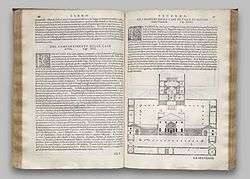
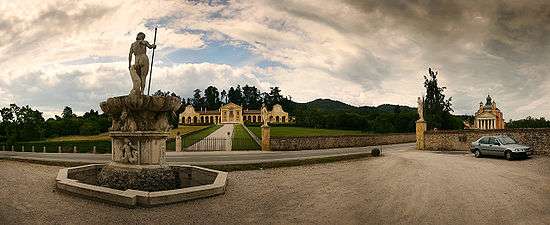
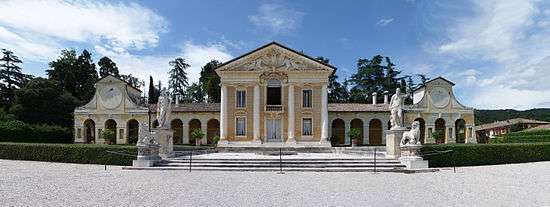 Villa Barbaro
Villa Barbaro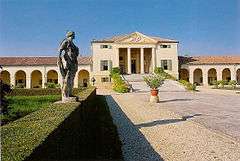
 Villa Emo
Villa Emo
Palaces
- 1540 (built 1540 – 1542): Palazzo Civena, for Giovanni Giacomo, Pier Antonio, Vincenzo and Francesco Civena, Vicenza (rebuilt in 1750 and after World War II)
- 1542 (built 1542 – 1558): Palazzo Thiene, for Marcantonio and Adriano Thiene, Vicenza (probably on a project by Giulio Romano)
- 1545: Palazzo Garzadori in contra' Piancoli, for Girolamo Garzadori, Vicenza (unbuilt, uncertain attribution)
- 1546 – 1549 (built 1549 – 1614): Loggias of the Palazzo della Ragione (then called Basilica Palladiana), Vicenza (completed in 1614 after Palladio's death)
- c. 1546 (built: 1546 – 1552): Palazzo Porto, for Iseppo da Porto, Vicenza
- 1548 (built 1548 – 1552): Palazzo Volpe in contra' Gazzolle, for Antonio Volpe, Vicenza (uncertain attribution)
- 1550 (built 1551 – 1557; c. 1680): Palazzo Chiericati, for Girolamo Chiericati, Vicenza (completed about 1680 after Palladio's death)
- c. 1555-c. 1566: Palazzo Pojana, for Vincenzo Pojana, Vicenza (attributed)
- c. 1555: Palazzo Dalla Torre, for Giambattista Dalla Torre, Verona (only partially realized; partially destroyed by a bombing in 1945)
- 1555 ?: Palazzo Poiana in contra' San Tomaso, for Bonifacio Pojana, Vicenza (unfinished)
- 1555 – 1556 ?: Palazzo Garzadori, for Giambattista Garzadori, Polegge, Vicenza (unbuilt project)
- c. 1556 (built 1556 – 1595): Palazzo Antonini, for Floriano Antonini, Udine (altered by later arrangements)
- After 1556: Loggia Valmarana in the Giardini Salvi, for Gian Luigi Valmarana, Vicenza (uncertain attribution)
- 1557 – 1558: Palazzo Trissino in contra' Riale, for Francesco and Ludovico Trissino, Vicenza (unbuilt project)
- 1559 (built 1559 – 1562): Casa Cogollo, for Pietro Cogollo, traditionally known as Casa del Palladio ("Palladio's home"), Vicenza (attributed)
- 1560 (built 1560 – 1565; 1574 – 1575): Palazzo Schio, for Bernardo Schio, Vicenza (façade)
- After 1561: Palazzo Della Torre ai Portoni della Bra', for Giambattista Della Torre, Verona (unbuilt project)
- 1564 (built 1565 – 1586): Palazzo Pretorio, for the town council, Cividale del Friuli, Province of Udine (project, attributed)
- 1564 ?: Palazzo Angaran, for Giacomo Angaran, Vicenza (unbuilt project)
- After 1564: Palazzo Capra al Corso, for Giulio Capra, Vicenza (unbuilt project)
- 1565 (built 1571 – 1572): Palazzo del Capitaniato (or Loggia del Capitanio), for the town council, Vicenza
- 1565 (built 1566 – 1580): Palazzo Valmarana, for Isabella Nogarola Valmarana, Vicenza
- 1569 (built 1570 – 1575): Palazzo Barbaran da Porto, for Montano Barbarano, Vicenza
- 1571 ? (built 1572 – 1585): Palazzo Porto in Piazza Castello, for Alessandro Porto, Vicenza (unfinished; partially completed in 1615 by Vincenzo Scamozzi)
- 1572 ? (built before 1586 – 1610s): Palazzo Thiene Bonin Longare, for Francesco Thiene, Vicenza (progetto; costruito da Vincenzo Scamozzi)
- 1574: Rooms of Palazzo Ducale, Venice
_-_facade_on_Piazza_dei_signori.jpg) Basilica Palladiana, Vicenza
Basilica Palladiana, Vicenza.jpg) Palazzo del Capitaniato, Vicenza
Palazzo del Capitaniato, Vicenza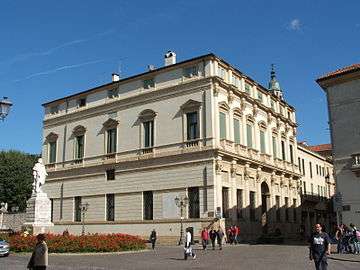 Palazzo Thiene Bonin Longare, Vicenza
Palazzo Thiene Bonin Longare, Vicenza
Church architecture
- 1531: Portal for the church of Santa Maria dei Servi, Vicenza (attributed; with Girolamo Pittoni and Giacomo da Porlezza)
- 1537: Monument to Girolamo Schio, Bishop of Vaison in the Cathedral of Vicenza (with Girolamo Pittoni, attributed)
- 1558 (built 1558 – 1559; 1564 – 1566): Dome of the Cathedral, Vicenza (destroyed in a bombing during World War II, then rebuilt)
- 1559: Façade for the Basilica of San Pietro di Castello, Venice (completed after Palladio's death)
- 1560 (built 1560 – 1563): Refectory of the monastery of San Giorgio Maggiore, Venezia
- 1560 (built 1561 – 1562): Convento della Carità, Venice (only the cloister and the atrium destroyed in 1630 in a fire)
- 1560: Monument to Giano Fregoso in the church of Santa Anastasia of the Dominicans, for Ercole Fregoso, Verona (uncertain attribution; with Danese Cattaneo)
- After 1563: Funeral monument to Luigi Visconti in the cloister of the Chapter in the Basilica of Saint Anthony, Padua (attributed)
- 1564 (built 1564 – 1565): North portal and Almerico Chapel in the Vicenza Cathedral, for Paolo Almerico, Vicenza
- 1564: Façade for the church of San Francesco della Vigna, for Giovanni Grimani, Venice
- 1565 (built 1565 – 1576): Church of San Giorgio Maggiore, for the Congregation of Santa Giustina, Venice (completed between 1607 and 1611, after Palladio's death, with a different façade, by Vincenzo Scamozzi)
- 1574: Façade for San Petronio Basilica, Bologna (studies)
- 1574 or 1579 ?: Church of Le Zitelle, Venice (uncertain attribution)
- c. 1576 (built 1576 – 1580): Valmarana Chapel in the Church of Santa Corona, for Isabella Nogarola Valmarana, Vicenza
- 1576 (built 1577 – 1586): Church of Il Redentore, Venice
- 1578 (built 1588 – 1590): Church of Santa Maria Nova, Vicenza (project attributed, completed after Palladio's death)
- 1580: Church of Santa Lucia, Venice (drawings for the interior; demolished)
- 1580 (built 1580 – 1584): Church of Villa Barbaro (Tempietto Barbaro), for Marcantonio Barbaro, Maser, Province of Treviso
Other
- 1536: Portal of the Domus Comestabilis, Vicenza (attributed)
- 1550 (built 1550 – 1552): Bridge on Cismon, Cismon del Grappa, Province of Vicenza (destroyed)
- 1556: Arco Bollani (an arch over the road leading to the Udine Castle), for Domenico Bollani, Udine (attributed)
- 1561: Wooden theater in the Basilica for the play L'Amor Costante by Alessandro Piccolomini, for the Accademia Olimpica, Vicenza
- 1562: Wooden theater in the Basilica for the play Sofonisba by Giangiorgio Trissino, for the Accademia Olimpica, Vicenza
- 1566: Rialto Bridge (Ponte di Rialto), Venice (unbuilt project)
- 1567; 1569: Ponte Vecchio, Bassano del Grappa, Province of Vicenza (rebuilt in 1748 and after World War II)
- 1569 o 1580 ? (built 1580 – 1588): Bridge on Tesina, Torri di Quartesolo, Province of Vicenza (attributed)
- 1576 (built 1595): Arco delle Scalette, for Giacomo Bragadino, Vicenza (attributed, built after Palladio's death)
- 1579: Porta Gemona, for the town council, San Daniele del Friuli, Province of Udine
- 1580 (built 1580 – 1584): Teatro Olimpico, for the Accademia Olimpica, Vicenza (completed after Palladio's death by Vincenzo Scamozzi)
References
- 1 2 "Andrea Palladio (Italian architect) – Britannica Online Encyclopedia". Britannica.com. Retrieved 25 March 2013.
- ↑ The Center for Palladian Studies in America, Inc., His conception of classical architecture was heavily influenced by Vitruvian ideas and his mentor Trissino. "Andrea Palladio."
- ↑ The Houghton Mifflin dictionary of biography. Houghton Mifflin. 2003. p. 1167. ISBN 0-618-25210-X.
- ↑ Moose, editor, Christina J. (2005). Great lives from history. Pasadena, Calif.: Salem Press. ISBN 978-1-58765-211-0.
- ↑ He visited Rome alongside Trissino in 1541, 1547, and 1554 until 1556. His earlier visits to Rome influenced his designs of palaces. He modeled his designs based on his interpretation of classical architecture he had witnessed. Curl, James Stevens, "A Dictionary of Architecture and Landscape Architecture", Oxford University Press
- ↑ "How I Spent A Few Days in Palladio's World" The Wall Street Journal, 3 March 2009, WSJ.com
- ↑ Mostra del Palladio: Vicenza / Basilica Palladiana (in Italian). Electa. 1973. p. 46.
- ↑ Venice and the Renaissance", Manfredo Tafuri, trans. Jessica Levine, 1989, MIT Press, p.127 Books.Google.com ISBN 0-262-70054-9
- ↑ Palladio knew relatively little about Greek architecture, not yet rediscovered at his times, but he studied deeply the Roman remains during five trips to Rome. His works are heavily influenced by his studies of Greco-Roman architecture.
- ↑ Howard Burns, Andrea Palladio (1508–1580) Archived 24 September 2009 at the Wayback Machine., Centro Internazionale di Studi di Architettura Andrea Palladio
- ↑ Dr Nebahat Avcioglu (23 December 2013). Architecture, Art and Identity in Venice and its Territories, 1450–1750: Essays in Honour of Deborah Howard. Ashgate Publishing, Ltd. p. 150. ISBN 978-1-4724-1082-5.
- ↑ For the illusionistic landscape paintings and the relationship of Palladio and Veronese see http://www.kunstgeschichte-ejournal.net/329/1/Paolo_Veronese%2C_Andrea_Palladio_und_die_Stanza_di_Baco.pdf
- ↑ P. Clini "Vitruvius' Basilica at Fano: The drawings of a lost building from 'De Architectura Libri Decem'" The International Archives of the Photogrammetry, Remote Sensing and Spatial Information Sciences, Vol. XXXIV, Part 5/W12 pp121 – 126 2002 ISPRS.org Archived 17 May 2012 at the Wayback Machine.
- ↑ "The US Congress: 'Palladio, the Father of American Architecture'". www.marcadoc.it.
- ↑ Collecting Palladio's drawings Archived 26 September 2009 at the Wayback Machine., website of the Royal Institute of British Architects, accessed 24 April 2010
- ↑ Inigo Jones Archived 26 September 2009 at the Wayback Machine., website of the Royal Institute of British Architects, accessed 24 April 2010
- ↑ "Archived copy". Archived from the original on 10 July 2014. Retrieved 22 July 2014.
- ↑ Source: "Catalog of works [by Palladio]". CISA. Archived from the original on 30 October 2013. Retrieved 11 November 2013.
External links
| Wikimedia Commons has media related to Andrea Palladio. |
| Wikisource has the text of the 1911 Encyclopædia Britannica article Palladio, Andrea. |
| Wikisource has the text of the 1913 Catholic Encyclopedia article Andrea Palladio. |
- Palladio and Britain Online exhibition from the Royal Institute of British Architects (in English)
- Palladio and The Veneto Online exhibition from the Royal Institute of British Architects (in English)
- Palladio Centre and Museum in Vicenza, Italy (in English) (in Italian)
- The Center for Palladian Studies in America, Inc.
- Palladio's Italian Villas website which includes material by the owners of Villa Cornaro
- Official Website of the 500 Years Exhibition in Vicenza – Italy (2008) (in English) (in Italian)
- Quincentenary of Andrea Palladio's birth – Celebration Committee Describes a major exhibition touring venues in Italy, the United Kingdom, and the United States
- Year of Palladio
- Andrea Palladio on Empty Canon
- Andrea Palladio: His Life and Legacy, at the Royal Academy, review, The Telegraph, 2 February 2009
- David Linley on the influence of Andrea Palladio
- How I Spent A Few Days in Palladio's World, The Wall Street Journal, 3 March 2009
- All He Surveyed, Paul Goldberger, The New Yorker, 30 March 2009
- Principles of Palladio's Architecture: II, Journal of the Warburg and Courtauld Institutes, 1945
- Nature and Antiquity in the Work of Andrea Palladio, Journal of the Society of Architectural Historians, September 2000
- Digital images of 1721 and 1742 edition of The architecture of A. Palladio
- Quattro libri dell'architettura From the Rare Book and Special Collections Division at the Library of Congress
- Andrea Palladio Architecture on Google Maps
- Bertotti Scamozzi, Ottavio, "Le fabbriche e i disegni di Andrea Palladio : raccolta ed illustrati" 1776

_-_Gradinata.jpg)
